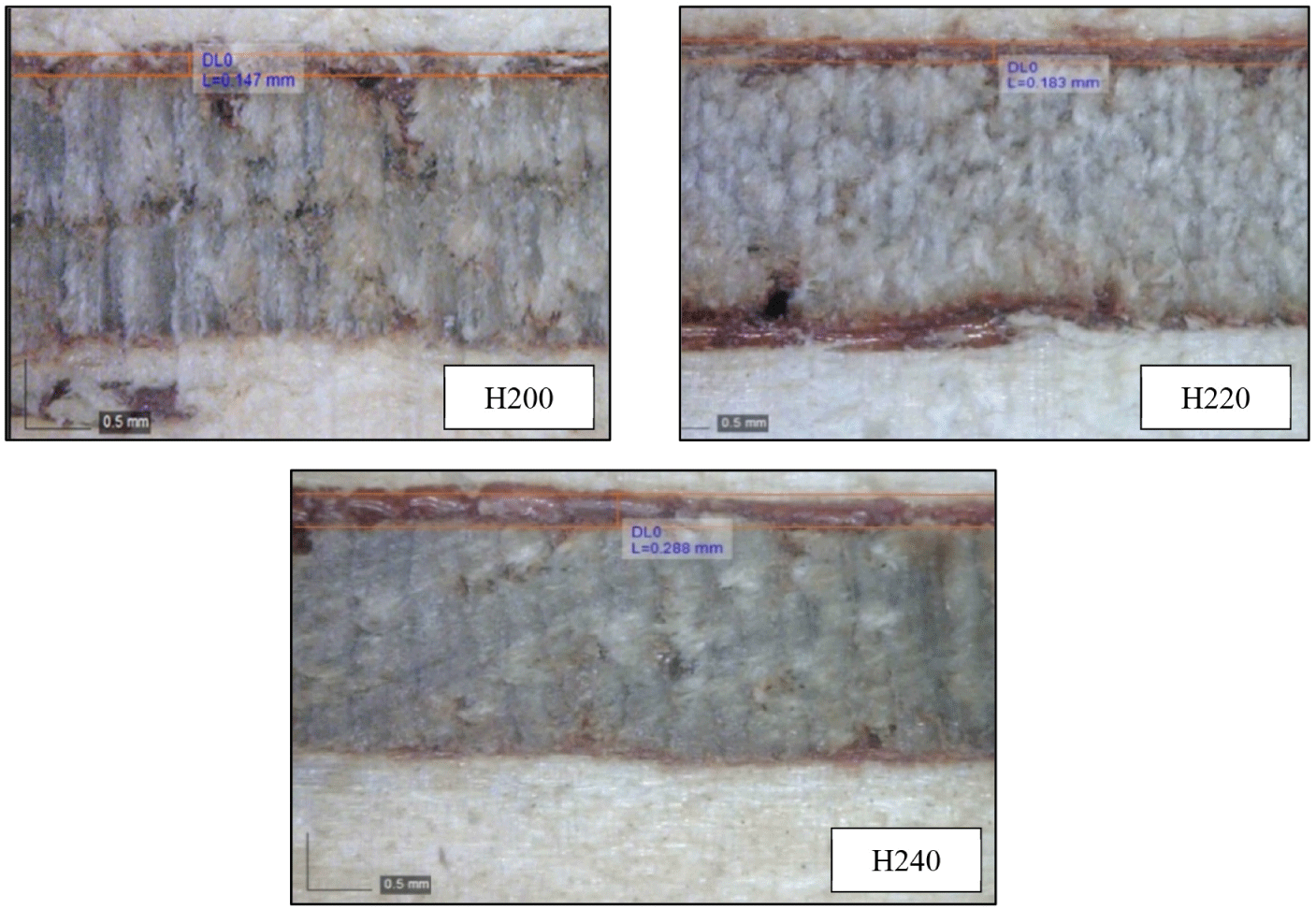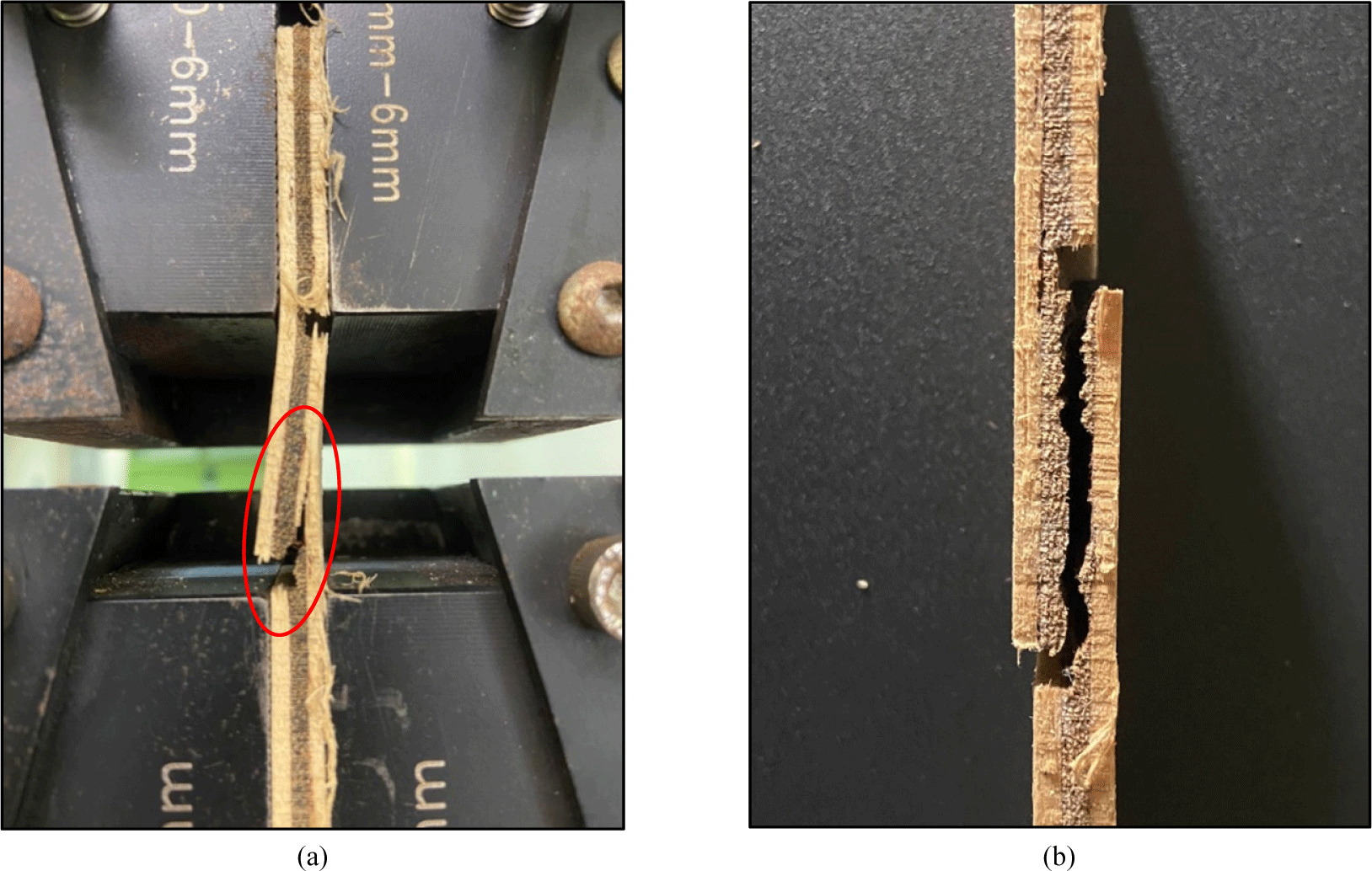1. INTRODUCTION
Plywood is a widely used engineered wood product, valued for its strength, durability, and cost-effectiveness in various applications. Using fast-growing species, such as Laran (Neolamarcia cadamba), in plywood production met growing interest, driven by their abundant availability and economic benefits (Nordahlia et al., 2014). However, concerns remain related to the bonding performance and structural integrity of plywood made from these species, with a particular focus on how veneer characteristics influence adhesive performance (Li et al., 2020).
High-quality plywood manufacturing depends on effective adhesive bonding and pressuring condition optimization (Demirkir et al., 2013). As plywood is often used in structural applications (Candan and Akbulut, 2014), understanding its mechanical properties is crucial when incorporating both fast-growing and traditional species like Red Saraya (Shorea curtisii). The bond quality is a critical factor in plywood suitability for specific applications and its capacity to withstand varying environmental conditions (Esteban et al., 2011). Among the factors influencing bond strength, the adhesive application process, especially glue spread rate, is significant. Ensuring optimal adhesive penetration and coverage is vital for strong inter-layer bonding and plywood structural integrity maintenance.
Phenol formaldehyde (PF) resin is among the most widely used adhesives in plywood production, renowned for its strength and durability. While PF resin efficacy is well-documented, research focusing on the interaction between PF resin and hybrid plywood, especially made of species like Laran and Red Seraya, remain scarce. In this study, we aimed to investigate how glue spread rates could affect hybrid plywood bonding performance when bonded with PF resin. Beyond assessing adhesive performance, we also evaluated surface wettability and other species-specific properties of Laran and Red Seraya veneers to better understand their role in adhesive penetration and bonding efficacy.
2. MATERIALS and METHODS
We obtained Laran (N. cadamba) and Red Seraya (S. curtisii) veneers, with densities of 390–447 and 472–639 kg/m3, respectively, from Perusahaan Kosinar Sdn. Bhd. in Keningau, Sabah. Veneer dimensions and moisture content (MC) were as follows: 310 × 310 × 1.8 mm (length × width × thickness) and 6%–8%, respectively. We purchased commercial PF adhesive (solid content = 44%, pH = 12, viscosity 60–67 cps at 30°C) from Sepanggar Chemicals Sdn. Bhd, and used ammonium chloride (NH4Cl) and H500A (an industrial hardener) as a catalyst.
We determined the buffering capacity based on Redzuan et al. (2019). We heated approximately 25 g of oven-dried wood powder (< 2 mm) in 250 mL of distilled water at 100°C for 30 min, then cooled it to 20°C for 24 h. We performed manual titrations on the aqueous extract using 0.1 N sodium hydroxide (NaOH) and 0.1 N sulfuric acid (H2SO4) solutions, added incrementally until reaching pH 11.0 and pH 3.0, respectively. We recorded the pH value after the addition of every 0.5 mL.
Using modified methods from Aydin (2004) and Paridah et al. (2009), we measured the contact angle of each veneer species using 5.0-μL droplets of distilled water, 0.5 M NaOH, and 0.5 M of hydrochloric acid (HCl) solutions, performing measurements at 0, 60, and 120 s as well as 5 min on 100 × 40 × 1.8-mm (length × width × thickness) veneer surfaces.
We produced three-ply hybrid plywood by manually applying a mixture of PF resin, wheat flour (4 wt%), ammonium chloride (NH4Cl; 1 wt%), and H500A (22 wt%) to the veneer surfaces at spreading rates of 200, 220, and 240 g/m2 using single glue lines. We used Laran and Red Seraya veneers for the faces and core, respectively. We initially cold-pressed the panels with 8 kgf/cm2 for 20 min, followed by hot pressing for 5 min at 140°C and a pressure of 10 kgf/cm2. We conditioned the specimens at a relative humidity of 65 ± 3% for one week.
We determined plywood density (D) and MC according to ISO 13061-2:2014, using 18 samples for the measurements. We assessed water absorption (WA) and thickness swelling (TS) by soaking the plywood samples in water for 24 h, following ISO 16983 (International Organization for Standardization, 2003a).
We conducted static bending tests as per ISO 16978 (International Organization for Standardization, 2003b). We cut the specimens into 170 × 50 × 5.8-mm rectangles, testing nine replicates using a Universal Testing Machine (Gotech/AI-7000L-10).
We performed shear strength tests to evaluate glue bond quality in accordance with ISO 12466-1 (International Organization for Standardization, 2007a) and ISO 12466-2 (International Organization for Standardization, 2007b), applying two pre-treatments, i.e., 24-h cold soak and BDB. For the former, we immersed the samples into water at 20 ± 3°C for 24 h. For the latter, we immersed the samples into boiling water for 4 h, dried them in a ventilated oven at 60 ± 3°C for 16–20 h, then re-immersed them into boiling water for 4 h, and cooled in water at 20 ± 3°C for at least 1 h. We performed shear tests on wet specimens, applying the load at a constant rate to ensure rupture within 30 ± 10 s. We measured the shear area at a ± 0.1-mm accuracy prior to the pre- treatment, and performed testing at a crosshead speed of 1 mm/min using a Universal Testing Machine with 72 replicates (Fig. 1). Finally, we assessed bonding quality based on the wood failure percentage within the bonding area.
We conducted analysis of variance (ANOVA) to assess how different (200, 220, and 240 g/m2) PF resin glue spread rates affect plywood bonding performance using the SAS statistical package. Following ANOVA, we applied Duncan’s multiple range test for post-hoc comparisons at a significance level of p ≤ 0.05. For clarity, we categorized the samples into five groups (Table 1).
3. RESULTS and DISCUSSION
Laran displayed higher sensitivity than Red Seraya, as indicated by a steeper line in the sensitivity graph, reflecting more pronounced reaction to acidic conditions [Fig. 2(a)]. Red Seraya was more stable in acidic environments, requiring 3.20 mL of H2SO4 to lower its pH from an initial 7.52 to 3.0. In contrast, it required only 3.30 mL of NaOH to increase the pH to 11. Laran exhibited higher alkaline buffering capacity, requiring more NaOH to reach a pH of 11 [Fig. 2(b)], potentially attributed to the weak lignin phenolic acid and unreacted acetyl group dissociations in the hemicelluloses, which contribute to wood acidity (Hernandez, 2012). During titration, these groups interacted with NaOH, indicating that higher acidity in Laran allows for better alkaline adhesive handling compared to Red Seraya.
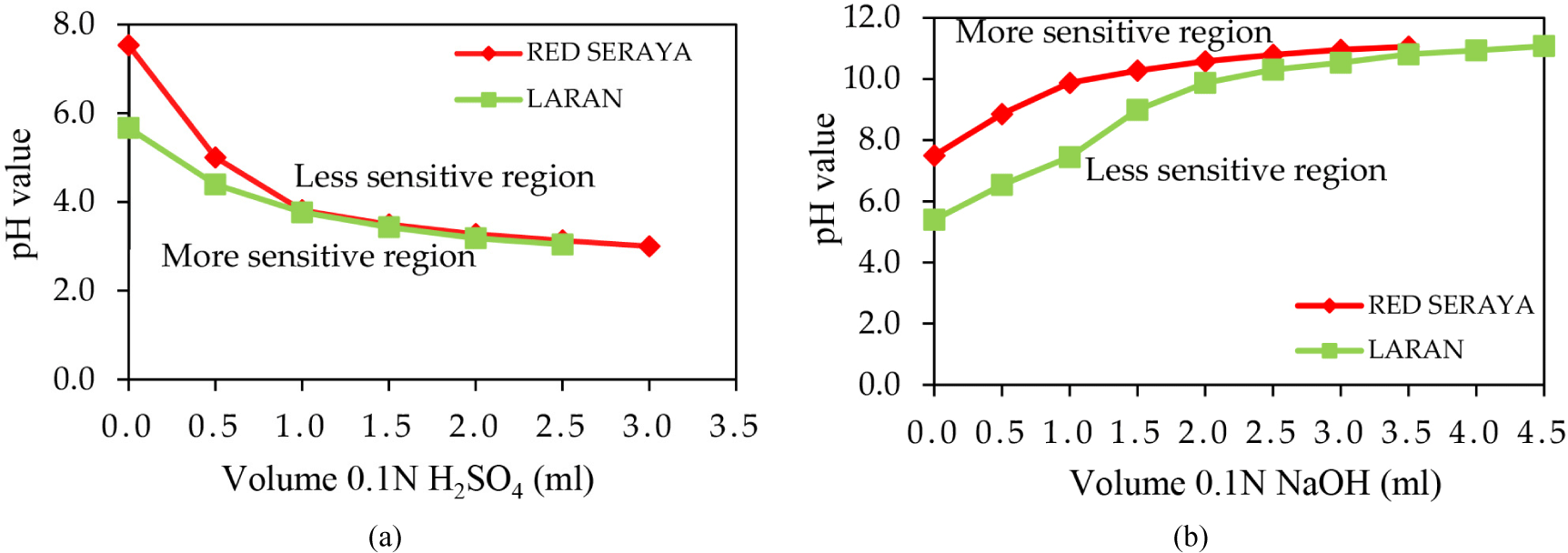
Red Seraya exhibited the lowest contact angle for distilled water (15°) and HCl (21.5°), indicating higher wettability than that of Laran. However, Laran displayed a significantly lower contact angle of 1° when exposed to NaOH, compared to 9.30° for Red Seraya (Fig. 3). The contact angle value-related differences between the two veneers for each liquid type were statistically significant (p ≤ 0.05). Red Seraya displayed larger contact angles, indicating lower wettability, potentially influenced by its species characteristics and density. Classified as light-to-medium-heavy hardwood (density range: 300–860 kg/m3; Sucipto et al., 2018), Red Seraya typically exhibits lower wettability due to its higher density and rough texture, potentially hindering liquid penetration.
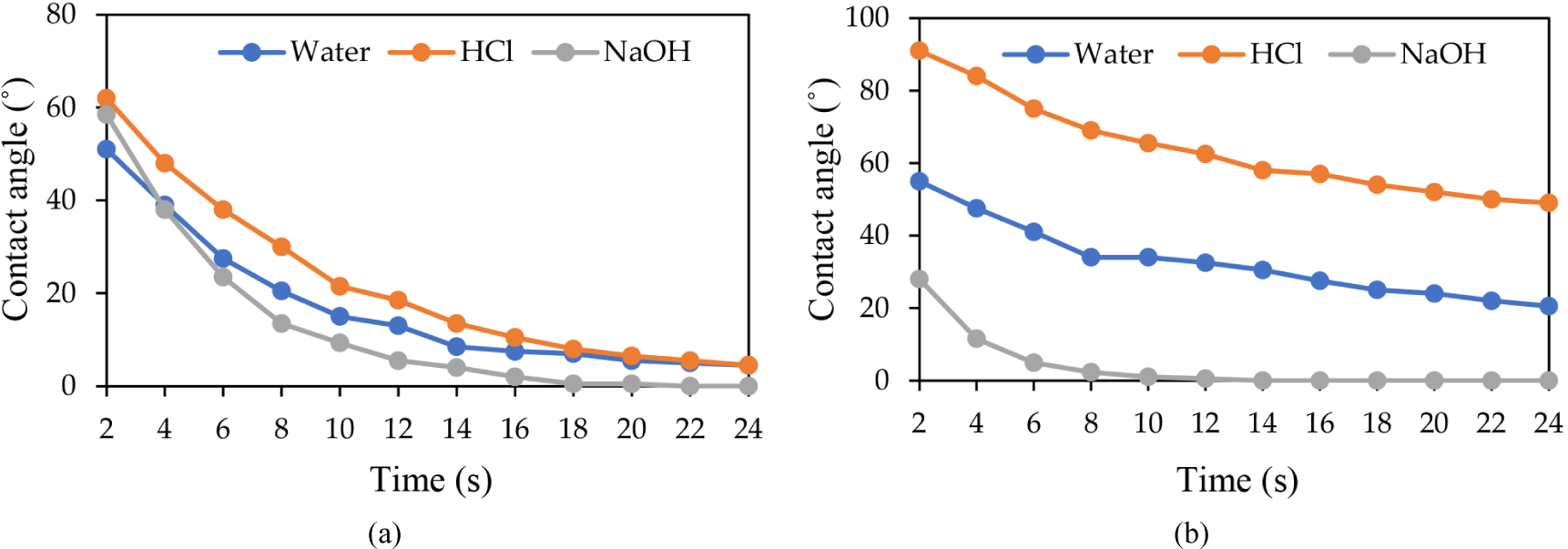
Plywood density at different glue spread rates ranged from 437.10 to 635.53 kg/m3 (Table 2), with highly significant differences between the plywood panels (p ≤ 0.001). Moreover, hybrid plywood density increased with increasing glue spread rates from H200 to H220, a variation primarily attributed to species-specific differences in porosity and surface energy, affecting glue absorption and retention. For instance, the superior wettability of Laran facilitates deeper adhesive penetration, while higher density in Red Seraya contributes to enhanced mechanical resistance. However, at the highest glue spread rate (H240), density slightly decreased despite the increased adhesive amount. This decline might be attributed to excessive glue consumption leading to voids in the glue line (Frihart and Hunt, 2021). Such conditions could reduce compaction efficiency and contribute to internal defects, ultimately lowering density. Adhikari et al. (2016) and Kallakas et al. (2020) described similar effects, noting that excessive glue could compromise bond quality due to uneven glue distribution and inadequate curing.
WA and TS in the plywood panels ranged from 46.02% to 82.44% and 1.78% to 3.61%, respectively (Table 2). Laran plywood (L220) and Red Seraya plywood (S220) exhibited the highest and lowest WA and TS, respectively. Although the differences between the hybrid and control plywood panels were highly significant (p ≤ 0.001), those between hybrid plywood panels H200 and H220 were non-significant (p > 0.05). Although increasing glue spread from H200 to H220 initially reduced WA rates, the latter increased again at spread rates beyond 220 g/m2. Excess adhesive might fail to fill voids effectively, leading to larger gaps between plywood fibers and greater water penetration, resulting in increased swelling and thickness (Bekhta et al., 2020b; Buyuksari, 2012).
Glue spread level significantly influenced the modulus of elasticity (MOE) and modulus of rupture (MOR) in hybrid plywood. Notably, the control Red Seraya (S220) plywood demonstrated superior MOE and MOR values compared to the hybrid (Table 3), highlighting that veneer density and species-specific properties dominantly influence mechanical performance. Red Seraya, being denser and structurally stronger than Laran, contributes more significantly to load-bearing capacity and stiffness, regardless of adhesive quantity. ANOVA results indicated significant differences in MOE among the plywood panels at different glue spread rates (p ≤ 0.05), while the difference in MOR was highly significant (p ≤ 0.001). Within the hybrid plywood group, glue spread rate increase from 200 to 220 g/m2 led to noticeable improvements both in MOE and MOR, suggesting that an adequate adhesive level enhances load distribution across veneer layers by improving the glue line interface. However, when the glue spread rate increased to 240 g/m2, both MOE and MOR declined, potentially attributed to excessive adhesive accumulation at the glue line, limiting penetration into the wood structure and potentially creating weak points. Thicker glue lines could reportedly generate internal stresses during curing and reduce flexibility, ultimately compromising bond integrity (Bekhta and Marutzky, 2007; Bekhta et al., 2020a; Khoo et al., 2021).
Sufficient adhesive penetration into the wood substrate is crucial for establishing strong and durable bonds (Yusoh et al., 2021). Glue-line thickness increased with higher glue spread rates, with notably thicker and more pronounced glue lines in the hybrid plywood at 220 and 240 g/m2 (Fig. 4). However, while a thicker glue line was evident at 240 g/m2, the corresponding decline in mechanical performance indicates that excessive adhesive could not compensate for veneer characteristics-related limitations. These observations emphasize that the interaction between the adhesive and the veneer substrate, rather than adhesive quantity alone, governs bond quality. Overly thick glue-line could reportedly introduce internal stresses during curing, particularly due to shrinkage, ultimately reducing shear strength and overall bonding efficacy (Pizzi and Mittal, 2017). In this context, veneer properties (e.g., porosity, density, and surface wettability) become critical as they influence how well the adhesive could penetrate and bond. This is further supported by the results in Table 3, indicating that hybrid plywood outperformed 100% Laran plywood both in MOE and MOR. This performance enhancement is primarily attributed to the inclusion of the denser Red Seraya veneer in the core layer, providing higher fiber density and improved load distribution, reinforcing the critical role of species characteristics in determining mechanical strength.
The control plywood made from Red Seraya and Laran (L220) consistently exhibited the highest and lowest shear strength across all treatments, respectively. This is in good alignment with the findings of Aydin and Colakoglu (2008), who emphasized that plywood properties are the most strongly influenced by density, with higher-density species generally exhibiting superior shear strength. The significantly higher shear strength of hybrid plywood containing Red Seraya veneer further supports this conclusion.
Among the hybrid plywood samples, the highest shear strength was observed at a glue spread rate of 220 g/m2. Statistical analysis revealed significant differences in shear strength between plywood panels at various glue spread rates under dry conditions and 24 h Cold soak pre-treatment (p ≤ 0.001). However, no significant difference was found for the BDB pre-treatment (p = 0.059). Notably, all plywood samples met the minimum shear strength requirement of 1.0 MPa as per the ISO 12466-2 standard (Fig. 5).
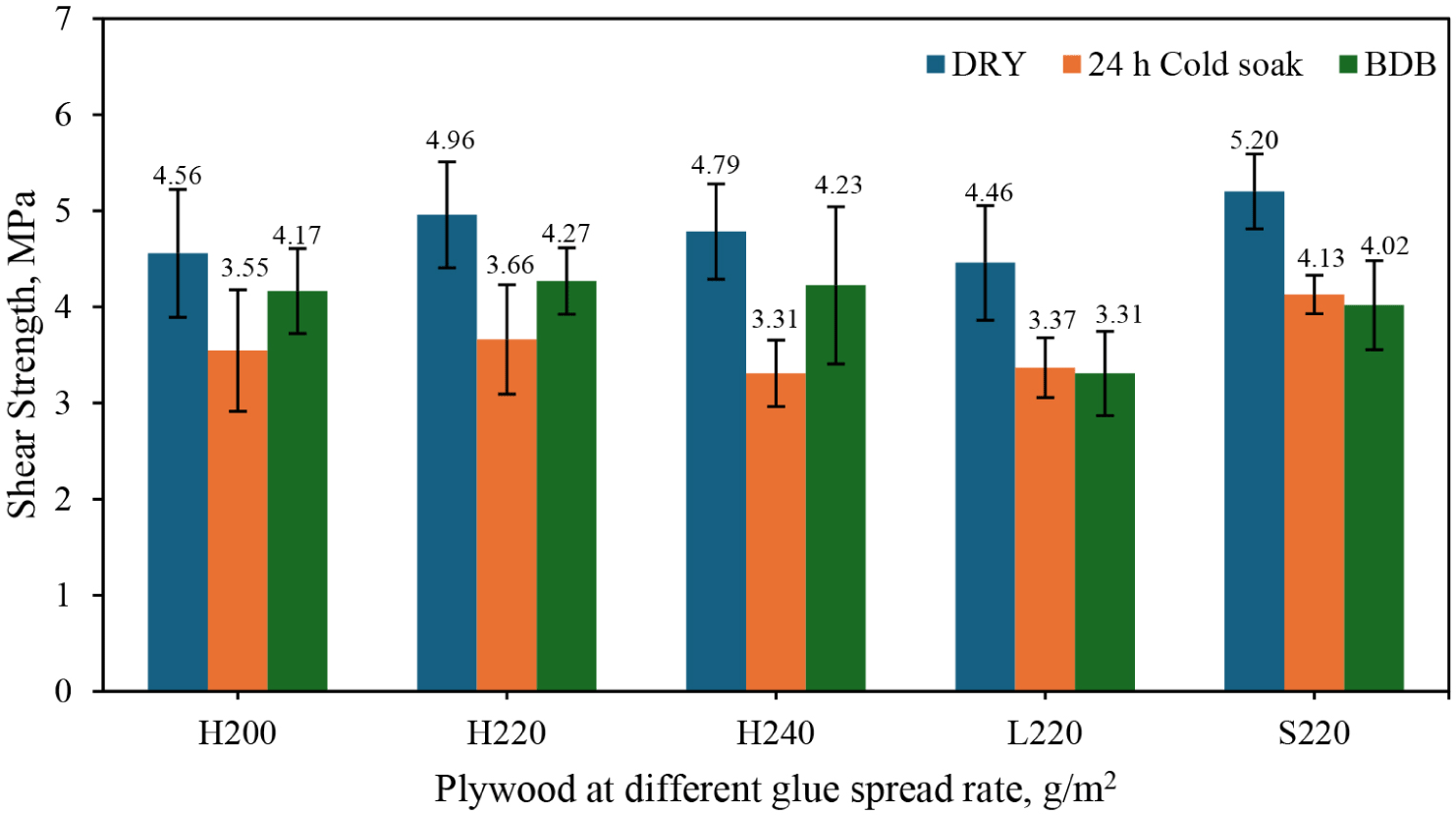
We observed a slight decrease in shear strength with glue spread rates exceeding 220 g/m2, aligning with the results of Li et al. (2020), describing excessive PF resin can lead to reduced shear strength. The interlocked grain and coarse texture of Red Seraya surface [Fig. 6(a)] may impede effective adhesive contact compared to the smoother Laran veneer structure [Fig. 6(b)]. Smoother surfaces retain adhesive better, leading to stronger bonds (Alia-Syahirah et al., 2019; Aydin et al., 2013; Palle et al., 2022). Pre-treatment samples displayed significant reductions in shear strength, likely due to adhesive bond weakening from dimensional changes during soaking (Karliati et al., 2019). The strength observed after the BDB test is lower than that after the 24-h cold soak test, which is commonly seen due to the anchoring effect deteriorating during boiling, influenced by various effects of the adhesive layer. In contrast, the hybrid panels exhibited higher strength after the BDB test than after the 24 h cold soak. This behavior may be attributed to the resin curing fully during the boil water test, compensating for under-curing of the glue-line during hot pressing (Xi et al., 2018). In addition, Belaidi et al. (2024) demonstrated that wood species have a more significant impact on shear strength than adhesive types, as the porosity of a wood species affects how much adhesive is absorbed, and different wood species possess varying strengths that influence the expected bond strength.
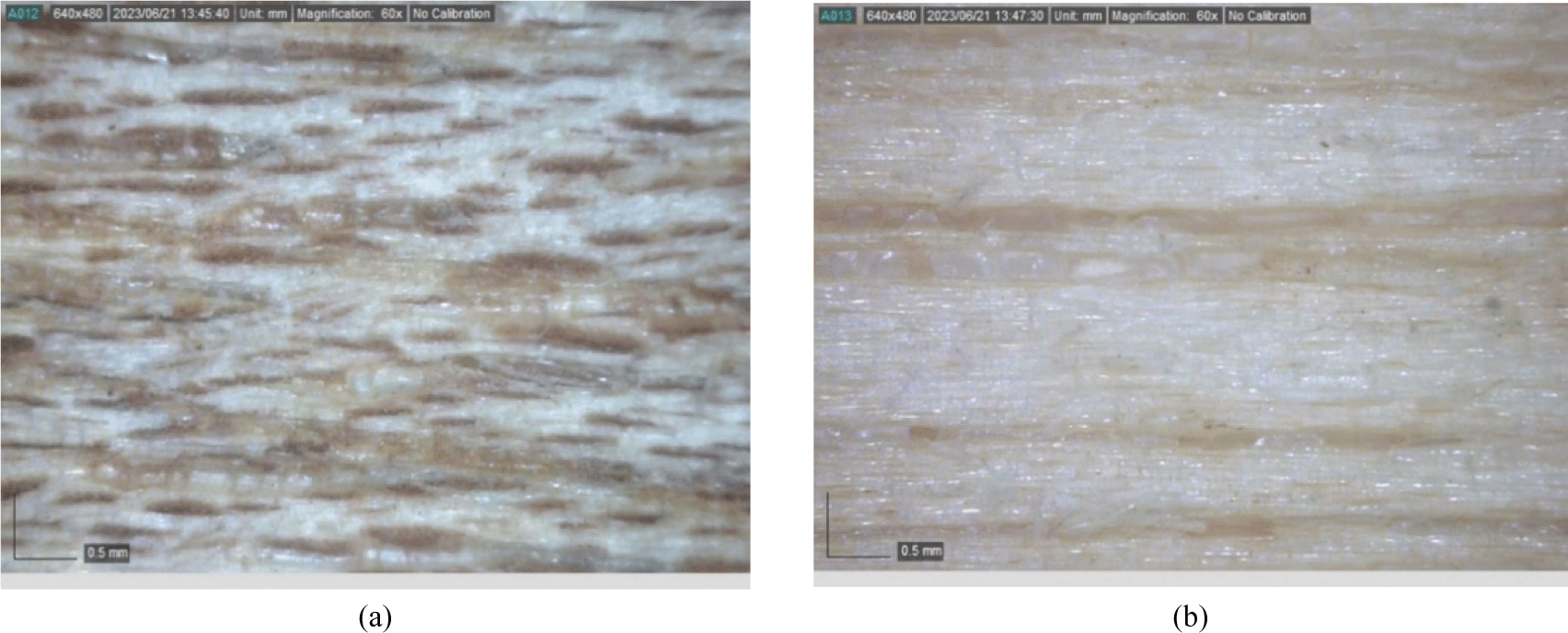
The types of wood failure observed are presented in Fig. 7. Two primary failure modes were identified: mixed-mode failure and cohesive failure. Most cohesive failures [Fig. 7(a)] occurred under dry conditions and 24 h cold soak pre-treatment, indicating strong adhesive performance. In contrast, a significant increase in mixed-mode failures [Fig. 7(b)] was observed when samples were subjected to BDB pre-treatment, suggesting that this condition adversely affects adhesive integrity. Overall, species-specific traits such as veneer density, grain orientation and surface roughness were more influential in determining bonding strength than marginal changes in glue amount, aligning with previous findings (Belaidi et al., 2024).
4. CONCLUSIONS
In this study, we demonstrated that plywood bonding performance is influenced by wood species combination, with high-density Red Seraya veneer contributing to enhanced mechanical strength and shear resistance. While PF glue spread rate variation effects were measurable, particularly at 220 g/m2, their impact remained relatively modest compared to the dominant role of veneer properties such as density wettability and buffering capacity. These species-specific characteristics strongly affect adhesive penetration and glue line integrity. Based on the above-described discoveries, a glue spread rate of 220 g/m2, combined with Red Seraya veneer, is recommended for an optimal performance. The results of this study could help plywood manufacturers select suitable veneer combinations and adhesive strategies to enhance product quality and efficiency.










